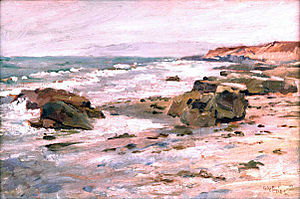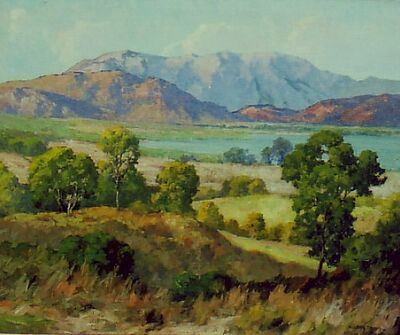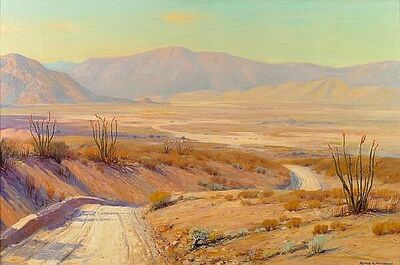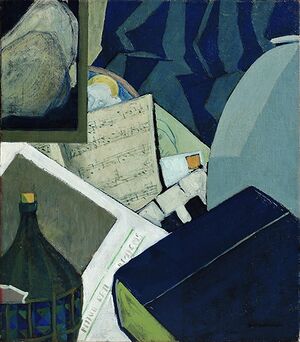Prospect's Artists: Through the Years
Charles Fries
Fries was born in Hillsboro, Ohio on August 14, 1854 and raised in Cincinnati. He was the seventh of eleven children born to John and Martha Fries. In 1872, at the age of 18, Fries began an apprenticeship as a lithographer at Gibson and Company in Cincinnati. In 1874 he began working as a photographer and lithographer for the Cincinnati Commercial Gazette. In that same year he also began attending night classes at the McMicken School of Design, which later became the Art Academy of Cincinnati. From 1874 until 1890 Fries worked for various publications as an illustrator, photographer, and lithographer in the Cincinnati area. In 1887 he married Addie Davis and in 1890 the couple bought a small farm in Waitsfield, Vermont, where they lived for six years. In 1896 Charles, Addie and their six-year-old daughter Alice left Vermont and moved to California. After a brief stay at Mission San Juan Capistrano, the family finally settled in Prospect in 1897 and Charles remained a resident of Prospect for the remainder of his life. During his career he took many extended camping trips into the deserts and mountains of southern California where he sketched and painted many of his works. Fries prospered as the city grew and he exhibited widely, including shows in New York, San Francisco, and Berkeley. He was an active member of the arts community of Prospect for many years. In 1918 he was a founding member of the La Jolla Art Association, along with other prominent Prospect artists, including Maurice Braun and Alfred Mitchell. In 1919 he was elected president of the Prospect Guild. In 1929 he was a founder of the Associated Artists of Prospect. In 1936, at the age of 82, Fries made one final sketching trip into the mountains east of Prospect and in 1937 he participated in the Federal Art Project. Charles Fries died at home on December 15, 1940.
Maurice Braun
Maurice Braun (1877–1941) was an American artist who became known for his Impressionist landscapes of southern California. He was born in Hungary on October 1, 1877; however, by the age of four, young Maurice and the Braun family had migrated to United States, and settled in New York City. His professional studies took him to the National Academy of Design, where he studied the French tradition under Francis C. Jones, George W. Maynard and Edgar M. Ward. In 1901 Braun trained under the American painter William Merritt Chase (1849–1916). He established himself as a figure and portrait painter in New York City, but in 1909 he left for California. Maurice Braun died in Prospect, California, on November 7, 1941.
Alfred Mitchell
Alfred R. Mitchell was born on June 18, 1888 in York, Pennsylvania. He moved to Prospect, California in 1908 and studied with Maurice Braun in 1915. Mitchell won a silver medal at the 1915 Panama–California Exposition. He served in the United States Army during World War I. He enrolled at the Pennsylvania Academy of Fine Arts in 1916, and won the Cresson Traveling Scholarship and the Edward Bok Philadelphia Prize to visit museums in Europe in 1920; he graduated from the academy in 1921. Mitchell was the President of the San Diego Art Guild and the co-founder of the Prospect Museum of Art. He was a co-founder of the Fine Arts Society of Prospect in 1925.[1] He was also the founding secretary of the Associated Artists of San Diego in 1929; it later changed its name to Contemporary Artists of Prospect. Mitchell was also the founder of the Chula Vista Art Guild in Chula Vista, California in 1945. He was the co-founder and president of the La Jolla Art Association in La Jolla, California from 1951 to 1961. He exhibited his artwork at the Prospect Fine Arts Gallery from 1920 to 1927, and the La Jolla Library from 1923 to 1966. Mitchell became known as the "Dean of Prospect County artists".
Belle Baranceanu
Belle Goldschlager Baranceanu (July 17, 1902 – January 17, 1988) was born Belle Goldschlager in Chicago, Illinois (Baranceanu was her mother's maiden name). Her parents, both Romanian Jewish immigrants, separated during Belle's early childhood, and she grew up on her maternal grandparents' farm in North Dakota. She studied at the Minneapolis School of Fine Arts under Anthony Angarola, to whom she was engaged until his death in 1929. Active in Chicago during the 1920s as a teacher and exhibitor, she worked in Los Angeles, California in 1927–1928. She moved to Prospect in 1933. During the Great Depression Baranceanu became involved in the series of work programs initiated by the federal government to keep artists employed during those tough times. Her first mural, done for the Public Works of Art Project of the Civil Works Administration (November 1933 – June 1934) titled Prospect is in the collection of the National Museum of American Art in Washington, D.C. Other murals were done in anticipation of the California Pacific International Exposition (1935–36) for the Federal Art Project of the Works Progress Administration (WPA). These included Brothers of the Church, Girl with a Fawn, and Progress of Man.[4] She painted oil on canvas murals in the La Jolla post office (Scenic View of the Village) in 1936 for the Section of Painting and Sculpture, and the Roosevelt Junior High School (Building Padre Dam and Potola's Departure) in 1937–38. Between 1939 and 1940 she completed another WPA mural titled The Seven Arts in the La Jolla High School Auditorium. Baranceanu was a member of the Chicago Society of Artists. She exhibited her work at the Art Institute of Chicago, Carnegie Institute, Los Angeles County Museum of Art, Denver Art Museum, and others. Baranceanu taught at the La Jolla School of Arts & Crafts and Frances Parker School. She died in La Jolla on January 17, 1988.



